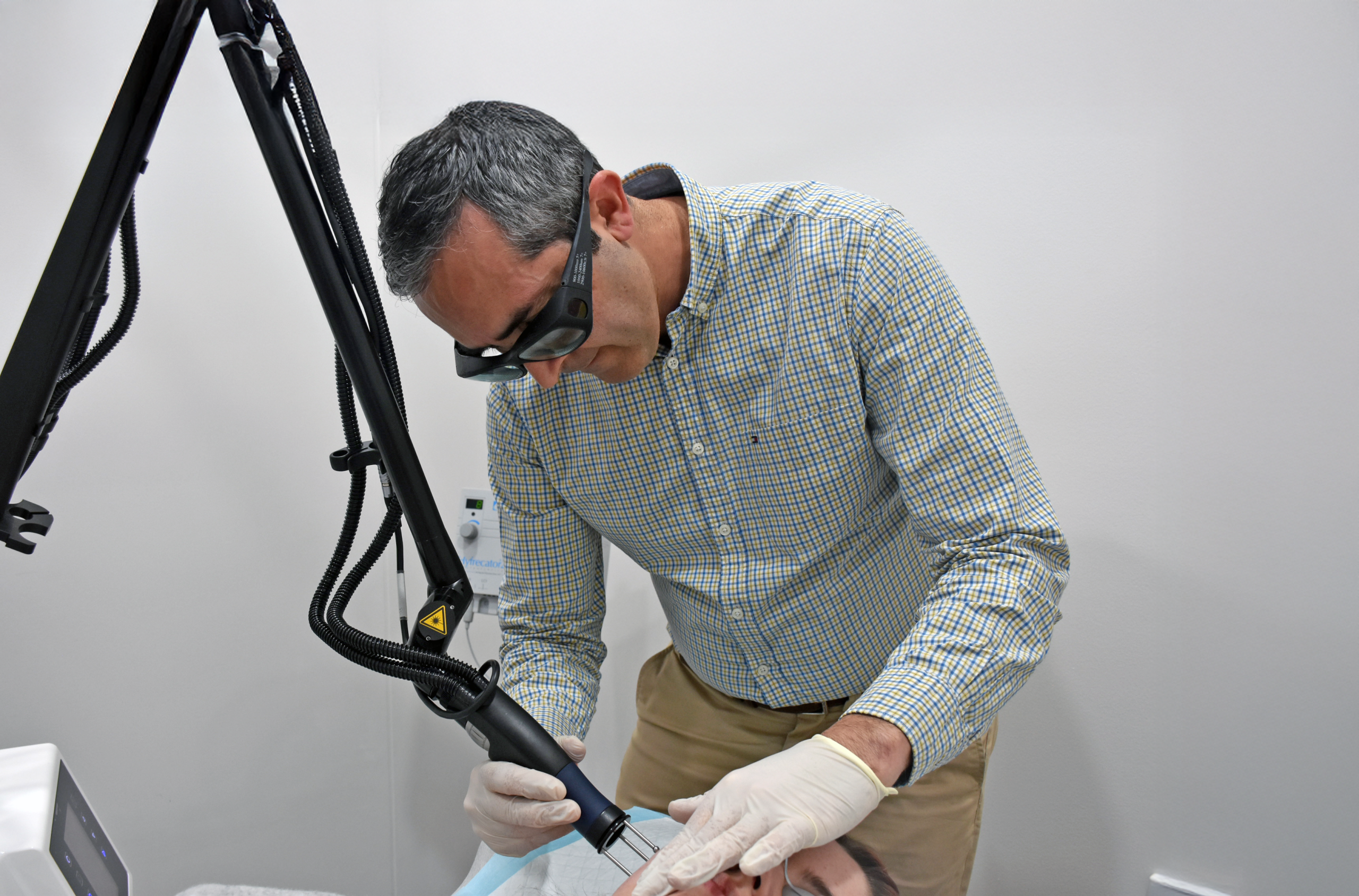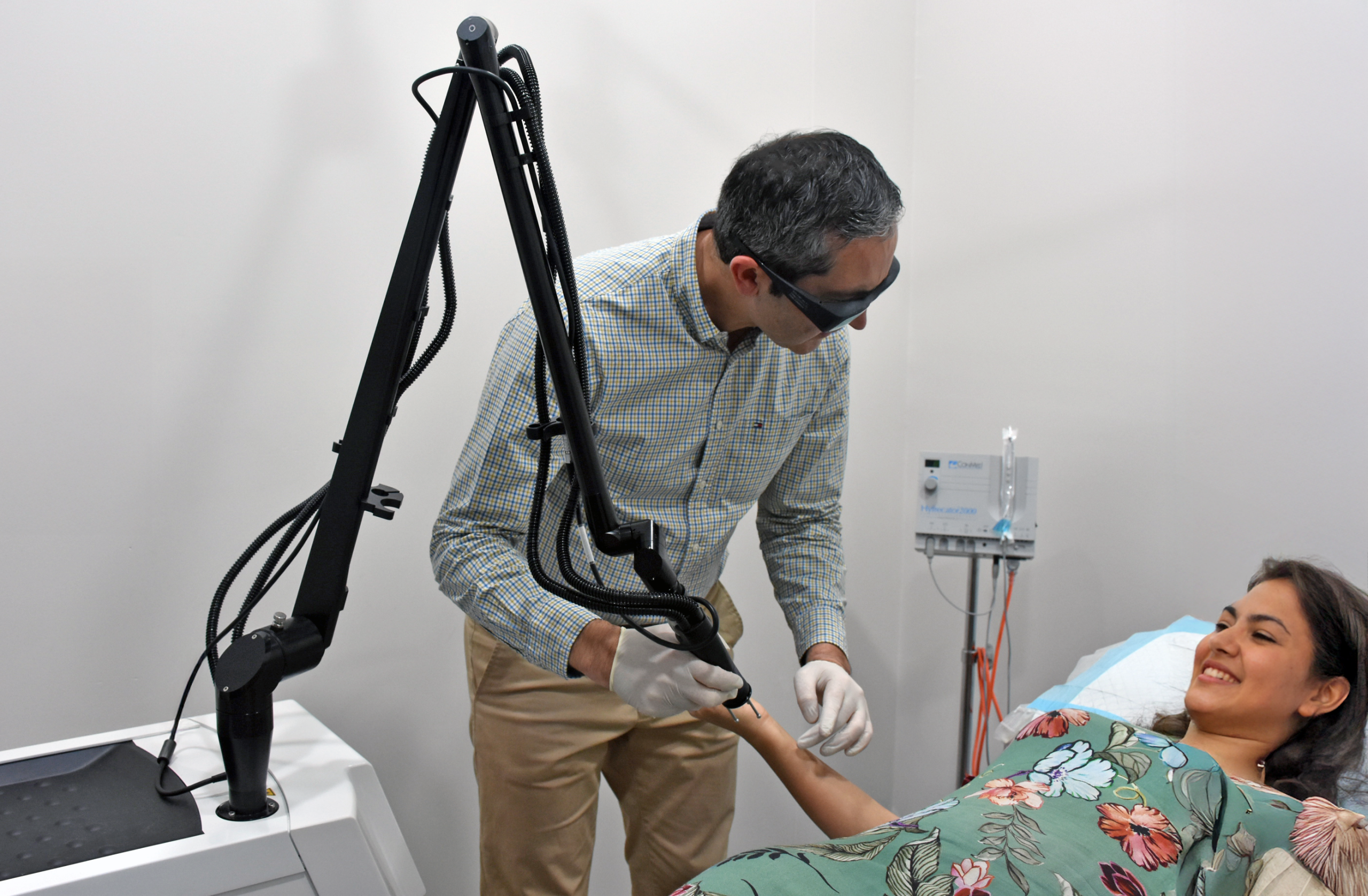Laser treatment
Erbium laser treatment can remove damaged or aged outer layers of skin, promoting the growth of new, healthier skin cells. It's a type of skin resurfacing that can address scars, pigmentation and other skin concerns.
What is an Erbium Laser?
The Erbium laser is a type of laser treatment used to improve the appearance and texture of the skin. It is commonly used for skin resurfacing, helping to reduce wrinkles, acne scars, pigmentation, and remove various skin lesions such as lumps and bumps.
This laser emits light at a wavelength of 2940 nanometres (nm), which is highly absorbed by water - a major component of human skin. Because of this strong attraction to water, the laser precisely removes (ablates) extremely thin layers of skin. Its precision makes it ideal for cosmetic procedures that require minimal thermal damage to surrounding tissue.
The erbium laser’s energy is rapidly absorbed upon contact with the skin, causing immediate vaporisation of surface tissue. It has a shallow penetration depth, as almost all of its energy is absorbed in the skin’s surface. This results in minimal heat spread to deeper skin layers, reducing recovery time and the risk of complications.
Expertise matters in laser treatments
At the Melanoma Centre, we believe that when it comes to laser treatments, the device itself is only part of the equation. Just as a master craftsman uses tools to create their best work, our Skin Doctors combine advanced knowledge of skin histology with expert use of laser technology to achieve the best possible outcomes. This expertise ensures results are effective while keeping risks to a minimum.
While devices such as the Erbium laser are powerful tools, it is the skill and experience of your Doctor that makes the difference. Every patient’s skin is unique, which is why a thorough assessment is carried out before any treatment. This ensures there are no underlying complications, and the procedure can be tailored precisely to your needs.
With specialist care and expert use of advanced technology, you can feel confident knowing your treatment is both safe and effective.
What Are the Main Uses of the Erbium Laser?
The erbium laser is primarily used in cosmetic and dermatological treatments to precisely remove ultra-thin layers of skin. This makes it ideal for skin resurfacing and treating a variety of skin concerns. Key applications include:
1. Scar Treatment
For atrophic (indented) scars, the erbium laser can significantly improve skin texture. By removing damaged outer layers, the treatment encourages the growth of new collagen and smoother skin, helping to soften the appearance of scars over time.
2. Treatment of Pigmentation
The erbium laser can also target surface pigmentation by removing the top layers of skin where pigmented cells are located.
3. Removal of Skin Lesions
This laser is effective in removing certain benign skin lesions that may not require surgical excision. Commonly treated conditions include skin tags, solar keratoses, and some non-cancerous moles (benign nevi). It is important to note that erbium laser treatment is not suitable for the removal of melanoma or other malignant lesions.


Fractional Treatments
-
Peeling
-
Skin tightening
-
Resurfacing
-
Wrinkles – periorbital (around the eyes)
-
Wrinkles – cheeks
-
Plissé lines – perioral (around the mouth)
-
Post-acne treatment
-
Scar reduction
-
Laser PDT (e.g., for actinic keratosis)
Ablative Treatments
-
Wrinkles
-
Lentigines (simplex or senile)
-
Nevi Spili
-
Stepped scars
-
Syringomas
-
Xanthelasmas
-
Adenoma sebaceum
-
Acne scars
-
Becker nevi
-
Café-au-lait spots
-
Epidermal nevi (soft)
-
Exophytic scars (flat scars)
-
Seborrhoeic keratosis
What Is Involved in Erbium Laser Treatment?
1. Consultation
Your journey begins with a consultation with one of our doctors to determine whether erbium laser treatment is right for you. Based on your skin type and concerns, you may need to prepare your skin in the weeks leading up to the procedure. This may involve using specific skincare products such as topical retinoids or hydroquinone for 4–8 weeks. These products help to reduce excess melanin and even out skin texture, which can minimise potential side effects like post-inflammatory hyperpigmentation or uneven skin response.
2. Before the Procedure
Patients are asked to arrive about 30 minutes before their scheduled treatment appointment. A topical anaesthetic cream may be applied in advance to numb the skin as needed. Just before the laser treatment begins, your skin will be thoroughly cleansed with a medical-grade solution to ensure a clean treatment area.
3. During the Procedure
The laser treatment itself is performed in our clinic by your doctor. The erbium laser is carefully applied to the target areas to resurface the skin with precision. The treatment time can vary depending on the size of the area being treated.
4. After the Procedure
Immediately following your treatment, an ointment may be applied to protect the skin and aid healing. For the first few hours after the procedure, it’s important to keep the area clean and dry. Ice packs or moisturisers can be gently applied about 6 to 8 hours post-treatment to help soothe the skin.
You may notice redness and swelling for several days afterward—this is a normal part of the healing process. To minimise irritation, avoid rubbing or applying pressure to the treated areas with clothing, towels, or bedding.